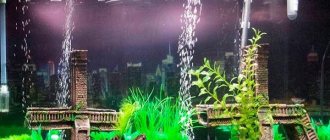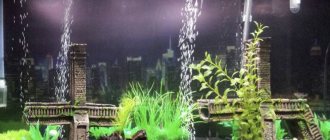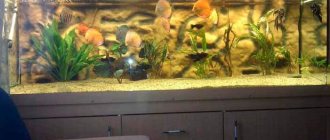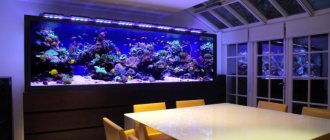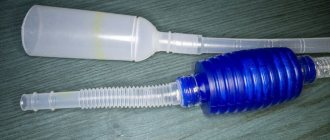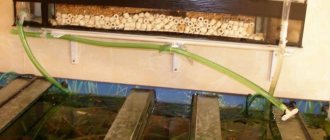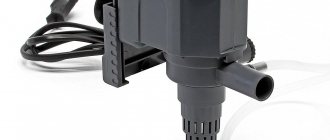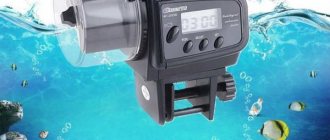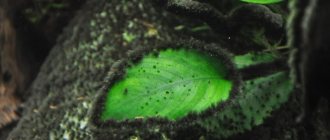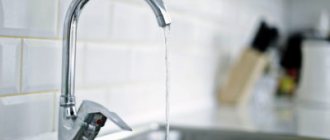Breeding aquarium fish seems like a simple task only at first glance. In fact, this event is quite troublesome, since silent pets require special care and the creation of special conditions that are as close to natural as possible. Before releasing fish into the aquarium, you need to purchase the necessary equipment: a water filtration and lighting system, a device for thermoregulation and, of course, a compressor for aerating and mixing the water. This is what will be discussed further.
Operating principle of an aquarium compressor
The device operates as follows:
- Compressor tubes immersed in water intensively release air bubbles, which enrich the water with oxygen molecules. The air pressure is regulated by special valves and clamps.
- When the device operates, ripples appear on the surface of the water, which increases the area of interaction between water and air, which contributes to additional saturation of the water with oxygen.
The compressor mixes layers of water in the aquarium, preventing it from blooming and spoiling. The operation of this apparatus is called aeration. Its main purpose is to provide the most favorable habitat for fish and preserve their health.
To aerate the aquarium, sprayers, most often made of white grindstone or an abrasive substance, are attached to the air tubes. Located at the bottom of the aquarium, they emit a lot of air bubbles, creating a very beautiful decorative effect.
The smaller the size of these bubbles, the larger their total area, which is more favorable for aeration of the reservoir.
The compressor should not be used constantly. It is quite enough to turn it on twice a day for about 20 minutes. In the summer, when the air temperature rises, the water also heats up and wastes oxygen much faster, so the device should be turned on more often and for a longer time.
The best compressors for medium-sized aquariums (100-250 l)
For medium-sized tanks, compressors with a capacity of up to 300 l/hour and a power of up to 4-4.5 W will be required. For large containers, it would be a good idea to buy two-channel devices.
Eheim Air Pump 200
4.9
★★★★★
editorial assessment
95%
buyers recommend this product
This wonderful membrane unit from the legendary German manufacturer is made of high-quality materials. With a good performance of 200 l/h and a power of 3.5 W, the device effectively pushes depths of up to 2 m in tanks with a volume of up to 250 l. The device has two individually adjustable air outlets of 100 l/h, equipped with diffusers. The compressor housing is equipped with vibration-absorbing rubber borders and soft legs, and can also be hung on a special hook.
Pros:
- Quiet operation;
- Suitable for fresh and sea water;
- The body is disassembled for repair;
- Each hose can have its own bubble mode;
- High-quality assembly and high wear resistance of materials.
Minuses:
- Does not include a safety check valve.
The quietest aerator in its class. Most users find this device to work quite reliably and for a long time.
Hydor H2ShOw Bubble Maker
4.8
★★★★★
editorial assessment
90%
buyers recommend this product
A very interesting submersible bubble generator from an Italian manufacturer will not only aerate the aquarium, but will also become a wonderful decoration of the underwater world. The housing rotating on the rotor creates a vortex of bubbles, the size and intensity of which can be adjusted.
The device is installed on the bottom at a depth of no more than 45 cm and reinforced with gravel - only the air intake tube is brought out. The power of the device is 4 W enough to saturate tanks with a volume of 50-200 liters with air.
Pros:
- Small sizes (16x14x7 cm);
- The hose is carefully attached to the glass with suction cups;
- Easy to disassemble and clean;
- Quiet operation;
- Easy installation;
- Reliability.
Minuses:
- Not suitable for deep aquariums.
The Hydor H2Show LED light can be attached to a special compressor pin and hidden inside a decorative object at the bottom. This way your aquarium will always please the eye, delighting your guests.
Tetra APS 300
4.8
★★★★★
editorial assessment
88%
buyers recommend this product
A membrane external compressor with a capacity of 300 l/h is capable of maintaining a comfortable environment for underwater inhabitants of a 120-250-liter aquarium, while consuming only 4.5 W. The device is characterized by quiet operation thanks to noise-reducing chambers built into the thickened body and rubber supports on the legs.
Two air supply channels are regulated by the included taps. The ultra-strong membrane and patented Silaflex valve guarantee long and stable operation of the device.
Pros:
- Unusual and futuristic appearance;
- High-quality plastic without foreign odors;
- Air filter on the tube;
- There is practically no vibration, and the noise from operation is not annoying;
- Easy to maintain.
Minuses:
- Hose and sprayers are not included.
The aerator is recognized by users as the best device in its class in terms of price-quality ratio, despite the fact that it will still have to be equipped with accessories.
Heiy Prime PR-4113
4.5
★★★★★
editorial assessment
86%
buyers recommend this product
A unique piezoelectric compressor from a Chinese manufacturer with a power of 3.5 W and a capacity of 24 l/h is designed for a tank with a volume of up to 200 l with a wall height of up to 1 m. The patented manufacturing technology of the device guarantees an extremely low noise level - 38 dB. The miniature aerator is attached using a silicone suction cup inside the aquarium and is equipped with a hose and a sprayer.
Pros:
- Almost invisible and inaudible:
- Very economical;
- Nice appearance;
- Widely available for sale;
- It's inexpensive.
Minuses:
- Does not push through long hoses with “foreign” sprayers;
- The suction cup does not hold well - periodically it dries out and falls off.
Numerous reviews from aerator owners say that the device “does not take” a depth of 1 m, but at a water column height of 55-60 cm, good thick bubbles are obtained, quite sufficient for a 150-liter tank. The compressor is so silent that it can be safely installed in the work area or bedroom.
READ ALSO
9 Best Aquarium Filters
Types of compressors
Aquarium compressors come in several types. The most common and long-known are:
- piston;
- membrane
Quite recently, silent aquarium compressors aPUMP have appeared on the markets. In addition, you can saturate the water with oxygen using conventional aquarium pumps or airlift filters.
With all the variety of device models, their main drawback is the noise they make. If the aquarium is located in the bedroom, the quiet operation of the device is one of its most important qualities. Unfortunately, a completely silent compressor for an aquarium does not exist, since the principle of any type of device is based precisely on vibration.
What to look for when choosing a compressor for an aquarium
- Type.
Membrane models practically do not wear out and do not require interruptions in operation. They consume less energy, but the power they develop is not as great as piston compressors designed for aerating large aquariums (generally from 150 liters). - Power supply.
Most devices run on mains power. If such a device is not equipped with a check valve, then if the light suddenly turns off, water from the aquarium can pour through the compressor onto the floor, not to mention the fact that the fish will be left without aeration. There are also battery-powered compressor options: they are usually small, portable, and have less power. In everyday life, it is useful to have both options: the main electric compressor and a spare battery-powered one. - Power
is measured in liters per hour and shows how much air will be supplied to the aquarium per unit time. The minimum power can be calculated using the formula: 0.5 l/h for each liter of water in the aquarium. - The depth
at which the compressor can be installed also plays an important role. The heavier the water column that the unit will have to overcome during operation, the more energy will be spent on this work. - The ability to regulate the voltage
and, accordingly, the volume of supplied air is useful, but is not present in all compressor models. - The presence of an air filter
that will clean the air from dust and other impurities before supplying it to the aquarium. - Noise level
. All compressors make noise, but to varying degrees. If the aquarium is in the bedroom, then it makes sense to purchase a relatively quiet model, spending a little more money, but be prepared for the fact that it will not be possible to completely get rid of the noise.
Diaphragm compressor
The air supply in such a device occurs through the movement of special membranes that work only in one direction. The device consumes little electricity. It is also a relatively silent aquarium compressor.
Its main disadvantage is low power. This aerator is not suitable for large containers. However, it is quite possible to install a small membrane device in a home aquarium up to 150 liters.
Piston compressor
This is also a silent aquarium compressor. The air in this model is supplied by a piston. Such devices have a long service life and fairly high performance. Thanks to their high power, they can be used in large aquariums.
Both types of home aerators are powered from household electricity or batteries. Each device includes a flexible hose for releasing the pumped air.
Recently, piezo devices have competed with piston devices. This is the quietest aquarium compressor. However, it also has a drawback - it is low-power and cannot be placed in containers larger than 200 liters.
Types of compressors
All quiet aquarium compressors are divided into 2 types based on internal mechanisms: membrane and piston.
The membrane type releases air through several internal moving membranes. The air flows in one direction and does not suck water into the device. Diaphragm compressors are characterized by low energy costs and operate almost silently, except for the splashing of water. But this type is only suitable for small tanks with a small population of fish, the volume of which does not exceed 150 liters. Valued as an inexpensive but durable aerator.
Piston compressors operate by having a piston inside, which pushes air through a tube. This species is not as quiet and produces a slight buzzing noise that is not too noticeable. They have a higher price, but are capable of enriching much larger volumes of liquid with oxygen. Low-priced piston devices are often not of good quality. They get quite hot, which will have a bad effect on the fish.
There are devices on sale that do not release air bubbles from the underwater tube, but are located on the surface. They create ripples in the water and constant movement of water, during which the water is enriched with oxygen. But this species is not suitable for keeping bottom fish.
Aerating devices are powered by electricity, but there are also battery-powered ones. Battery-powered aerators are used when transporting fish.
An alternative to a silent aerator for an aquarium are oxidizers. These devices are absolutely silent, because the process of enriching water with oxygen occurs due to chemical reactions. The device contains hydrogen peroxide, which decomposes into water and oxygen due to the action of metal catalysts.
View this post on Instagram
Post by Fish and Animal Supplies (@aqua.dom.laguna) Jul 12, 2021 at 10:08 am PDT
Aquarists also use aquarium pumps. This collar apump device combines the functions of an aerator and a filter - it enriches the air with oxygen and purifies the water. It is most often equipped in large-scale aquariums. The aquarium pump makes little noise due to its complete immersion in water.
For small volume
Aquael OxyBoost 300, Aquael, Triton, Sicce and DoPhin AP 1301 are considered suitable for small-volume tanks.
Aquael OxyBoost 300 is a fairly inexpensive and practical aerator. There are rubber mounts that reduce noise and vibration. Energy consumption is 2.5 W, and the amount of water distilled is 100 liters per hour. It is small in size. Disadvantage: rubber feet do not always reduce noise.
DoPhin AP 1301 is a miniature device that produces up to 95 liters per hour and consumes 1.7 W of energy. The maximum aquarium size for aeration is 125 liters. Noise level is low. The kit does not include additional equipment. If necessary, you will have to purchase it yourself.
Sicce is a low power aquarium equipment and is therefore well suited for small tanks. When mounted in a vertical position, vibrations are minimal due to special legs. It is possible to customize performance. Suitable for aquariums up to 100 liters.
Triton is a micro compressor manufactured by a Chinese company. Power 3 W and suitable for tanks up to 150 liters.
Aquael is produced by a Polish company. They create a minimal amount of noise and have an unusual
new appearance.
For large volume
The Schego Optimal and COLLAR devices are suitable for large tanks.
The Schego Optimal is designed for containers up to 300 liters and is capable of pumping 250 liters per hour. Consumes 5 W of energy. The vibrations are weak, so they create almost no noise. Using a tube splitter, the tubes from the device can be routed to several aquariums. The aquarist chooses the position himself: the compressor can be suspended in the air or attached on legs. The aerator has a high-quality membrane and a pre-filter; all this protects the device from contamination and damage. Long service life.
COLLAR is suitable for tanks of 200 liters and is suitable for large aquariums, although it itself is small in size. The height of the tube is 80 cm, and the power of the device is 3 W. The model has a long service life and high-quality parts. Suitable for any aquarium.
With high power
Powerful devices provide a sufficient amount of oxygen every day. This is especially important in densely populated reservoirs. The most common brands are Eheim, JBL ProSilent.
Eheim is produced by a German company and is of recognized quality. The device pumps 400 liters of water in an hour. The device is suitable for any aquarium. The kit also includes a sprayer and a long hose. Power consumption 5 W. The aerator works quietly and is almost invisible. The owner of underwater inhabitants is able to independently adjust the spray and flow power he needs. The disadvantage is the high cost.
JBL ProSilent features fully adjustable performance. The device is capable of pumping from 50 to 400 liters per hour with an energy consumption of 2.2 to 5.5 W. Aerators vary in type depending on their location in the aquarium. Silent operation is ensured by soft legs and a built-in muffler. Quite a high cost.
Portable
Portable devices are necessary during periods of fish transportation or during power outages. These compressors do not operate from the mains, like most devices, but from batteries located inside. The most common device is considered to be a compressor under the Hagen Marina brand. The device pumps 50 liters per hour and has a low price.
Aquarium pump
An aquarium pump is often used to saturate the water with oxygen. This small device has 2 functions - saturating water with oxygen and purifying it. The pump is purchased for large aquariums. This device does not make much noise because it is submerged in water. The only thing is that a slight specific whistle is produced by the tube for sucking air from the surface. But this problem can be solved. In modern pump models, the tubes are equipped with a plug. If you change its position, the intrusive noise can be significantly reduced and even get rid of it.
How to use
Disputes often arise in the operation of aerators. Some do not turn off the compressor, others turn it on only after the feeding process. But a more comfortable mode for fish will be a mode of alternating on and off at equal time intervals: operation for 2/2 hours (that is, air flows for 2 hours and the device is turned off for 2 hours) or 3/3 hours. But you shouldn’t take too long breaks, because the oxygen in the water decreases. Turn on the aerator after feeding - fish need a lot of oxygen to digest food.
How to choose a compressor
The most important indicators of an aquarium compressor:
- power;
- noiselessness;
- durability
- price of the device.
For aquariums located in the bedroom, choose a silent aquarium air compressor. For large containers you will need a unit with high power.
Any model is suitable for medium-sized aquariums. The most popular and widespread brands are JBL, Aguael, Hagen, Tetra.
The smallest and quietest compressor for an aquarium is aPUMP, produced by COLLAR and designed to supply water with the most vital and necessary element - oxygen. Used for containers from 10 to 100 liters and a water column height of up to 80 cm.
This silent aquarium compressor has received only the best reviews. Many people note that this is one of the best devices, it is not heard or seen.
Which compressor is better to buy for an aquarium?
All inhabitants of the aquarium, be it fish, shrimp or plants, need oxygen vitally. It is to saturate the water with O2 that the compressor is installed. In addition to its main function, it acts as a kind of decoration, decorating the water column with streams of small bubbles. The latter, rising upward, prevent the formation of a bacterial film on the surface and destroy dust, mix different layers of water to maintain the same temperature in all corners of the artificial reservoir.
When choosing a device, it is important to take into account the size and volume of the aquarium, the population density of living organisms and their oxygen requirements. If you plan to install the container in a nursery or bedroom, pay attention to the noise level emitted by the device.
The type of aerator is an important indicator:
- Diaphragm compressors are considered the most common - they are economical and efficient, although they are noisy.
- Piston engines are low-power, so they are much quieter.
- New products include incredibly quiet devices - piezo compressors and bubble generators powered by a rotor.
- In small aquariums, pumps with an air “suction” function or air-lift filters can be used as aerators.
Performance is a parameter indicating the amount of air driven by the device in a certain period of time. To correctly calculate the value you need, you should multiply the displacement of the container by a factor of 0.8. So, for small aquariums with a capacity of up to 100 liters, compressors with a value of 80 l/hour are suitable.
When choosing a compressor, you should take into account the number and species diversity of the inhabitants of the aquarium, as well as the presence of living vegetation.
The required power of the device directly depends on the performance, the height of the aquarium and the location of the device. Its value can fluctuate between 2-10 W. The longer the tube through which the air is “pressed”, the more powerful the device you will need. Aerating large tanks with a capacity of over 250-300 liters may require several devices or a multi-channel compressor with the ability to connect two or more tubes.
High-quality devices from well-known manufacturers offer additional features, such as adjustable air flow, universal power supply (mains and batteries/battery), cleaning filters in air supply tubes, etc.
Recommendations: 10 Best Aquariums
12 Best Aquarium Plants
16 best aquarium fish
How to reduce compressor noise
Let's look at ways to make an aquarium compressor silent.
We will need:
- Styrofoam;
- dish sponge;
- foam;
- tools.
We open the compressor housing, study its structure and the location of all parts. The cause of the cracking sound may be a membrane that is in contact with some convex part. Carefully make an undercut to the protruding part of the body or cut out an area that prevents the membrane from moving freely.
You can reduce the noise of the device by placing a dish sponge under it, which will absorb the sound.
The compressor can also be installed in a soundproof box or wrapped in foam rubber and secured with rubber bands.
The reason for the noise of the device may be that it is clogged or the internal parts are weakened. Cleaning it and securing loose parts will help correct the situation.
Noise reduction options
Even initially silent compressors can begin to make an audible buzzing and noise after a while. This is especially problematic when the aquarium is located in living rooms, bedrooms, or in large aquariums that require powerful devices. You can reduce the noise level at home too.
If the source of noise is the buzzing of the aerator against objects or glass, then placing a soft dish sponge under the compressor will solve the problem. The sponge will absorb noise and buzzing.
For the compressor, boxes are also made for partial insulation from wood or plastic, and the inside is covered with foam rubber.
If this does not eliminate the noise, then open the device without damaging the parts. Usually the noise is produced by the operation of the membrane pressing on the air. Carefully cut or saw off the interfering parts of the membrane and the noise will disappear.
The cause of unnecessary sounds and poor performance of the aeration device is often contamination of the internal parts. To prevent contamination, clean your aquarium monthly. The loose parts are still noisy. To stop the noise, simply tighten the loose parts.
Making a silent compressor for an aquarium with your own hands
If you know the basic operating principle of the device, you can assemble it yourself. First, the compressor takes in air and then gradually supplies it to the aquarium.
In order to assemble such a device, you need to prepare:
- rubber chamber;
- hand or pedal pump;
- tee (three-way tap);
- a plastic tube from a medical dropper, always with a clamp.
To make a compressor, we take three tubes from the tee: the first - to the hand (or pedal) pump, the second - to the rubber chamber, the third, made from a tube with a clamp, will be used as a hose from which air will flow into the aquarium. We firmly plug the end of this tube with a stopper, and in front of it in the tube itself we pierce several small holes with a needle. This is where the air will come out. It is important to ensure that all connections are tight and secure.
The principle of operation of such a homemade compressor is as follows: first, a tube leading from the pump to the chamber will be used to collect air. Then, when the air is collected and the chamber is filled to capacity, this tube will stop working and another one leading from the chamber to the outlet tube will begin to function. Using a special clamp, you can regulate the speed of the air that will come out. It is best to make the air flow as slow as possible.
In principle, the compressor is made by hand. The disadvantages of such a device are that the battery chamber needs to be periodically pumped up. For normal aeration of an aquarium with a volume of up to 100 liters, such pumping is carried out approximately twice a day. Therefore, a homemade compressor cannot be left unattended for a long time.
Aerator maintenance
In order for the compressor to perform all its declared functions efficiently and meet the parameters, you need to properly care for it, understand the principle of operation and carry out the necessary preventive work on time.
- As the device operates, the membranes can wear down, break, and filters become dirty. Air filters and rubber membranes need to be changed in a timely manner.
- The tubes periodically become clogged with suspensions, preventing oxygen from reaching the water. If you find a weak flow, few or no bubbles, immediately clean it.
- Sometimes crustacean inhabitants damage the hoses with their claws. You need to have spare ones on hand (not just hoses).
- In case the main aerator breaks down, there is a power outage, or the underwater world is transported to another place, it is advisable to have a spare mobile mini-compressor (battery-powered).

